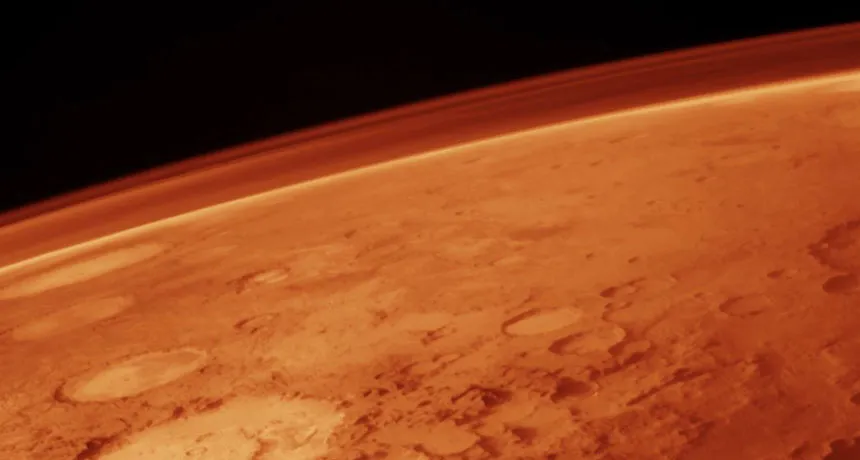Early Mars couldn’t hold liquid water long
Small craters point to a cold, dry past for the Red Planet

RETAINING WATER Mars’ thin atmosphere, seen in a photograph taken by Viking 1, was denser in the past but not dense enough to keep surface temperatures above the freezing point of water for long times.
NASA
- More than 2 years ago
Ancient Mars may have resembled Antarctica (but without penguins). The frozen Red Planet probably had liquid water on its surface for only relatively short times, according to a new analysis of craters on the surface. The finding that the Martian atmosphere was not dense enough to keep flowing water for more than a few hundred thousand years at a time adds to a growing pile of evidence that Mars probably remained cold and dry throughout most of its history, punctuated by brief periods of relative warmth.
Mars today has a very tenuous atmosphere, not nearly dense enough to keep water from instantly boiling away. But deep canyons and ancient river deposits point to a time when water flowed across the Red Planet. Researchers, however, disagree on whether those features indicate long-lasting temperate climates or brief bursts of warming interspersed throughout a long, dry winter.
To probe the early Martian atmosphere, Edwin Kite, a planetary scientist at Princeton University, and colleagues looked at ancient craters. A crater’s size reflects the size of the rock that hit the surface. In turn, the size of the rocks reflects the density of the air because the atmosphere heats up and breaks apart incoming boulders. Denser atmospheres destroy smaller rocks, while thinner air lets small rocks through.
By looking at crater sizes from Mars’ wetter past, Kite’s team estimated the minimum size of the rocks that made it to the surface. The researchers analyzed high-resolution images taken by the Mars Reconnaissance Orbiter of 316 craters near Gale Crater, where the Mars rover Curiosity has been exploring. These craters, interspersed with ancient river deposits, probably formed during a wetter epoch at least 3.6 billion years ago.
Kite’s team combined the crater sizes with computer simulations of impacts to estimate the atmospheric pressure from that time. The researchers report in the April 13 Nature Geoscience that the pressure was between about 90,000 and 190,000 pascals, which is not enough to sustain liquid water on the surface for an extended period.
Kite says the crater record suggests that the canyons and clays seen on Mars — signs of liquid water — formed during brief warm periods of less than 100,000 years. Such warm periods could be triggered by giant impacts or swings of the planet’s axis.
The early Martian environment, Kite says, was probably similar to certain parts of Antarctica where, despite subzero average temperature and negligible rain or snow, rivers flow and lakes fill during summer glacial melts. Even in this harsh environment microbial life endures, suggesting that life could have gotten a foothold on a mostly cold, dry Mars.
François Forget, a physicist at the Dynamic Meteorology Laboratory in Paris, is not surprised by Kite’s results. The crater data confirm Forget’s own climate simulations suggesting that Mars couldn’t hold on to a thick atmosphere. The Red Planet is so cold, he notes, that in a dense atmosphere any substantial carbon dioxide would condense and form ice caps, reducing the amount of the greenhouse gas in the atmosphere and further chilling the planet. “It’s very difficult,” he says, “to have a wet, warm Mars which looks like Earth does now.”
But some scientists disagree. “They’re opening a big can of worms,” says Ramses Ramirez, a planetary scientist at Pennsylvania State University in University Park. He takes issue with the Kite team’s assumptions about the Martian surface. A hard surface will create smaller craters than a soft one. Kite and colleagues assume the target rock is relatively soft. However, a soft surface may not be realistic, says Ramirez. Unless there was no bedrock or the underlying sediment did not harden much under its own weight, as it does on Earth, then the ancient Martian surface would have been harder than they claim. The sharp cliff faces within the ancient valley networks, great water-carved canyons hundreds of kilometers long and hundreds of meters deep, suggest a hard surface. “If Mars was as soft as they’re saying,” says Ramirez, “these features would have collapsed under their own weight like a sand castle.” But Kite responds that a softer surface is appropriate for the finely grained river deposits where the craters occur, similar to alluvial fans in Earth’s deserts.
Kite plans to analyze craters in other regions of Mars. Studying craters with different ages, he says, should help piece together the history of the atmosphere. Additionally, NASA’s Mars Atmosphere and Volatile Evolution, or MAVEN, mission, scheduled to arrive at Mars in September 2014, will study the present Martian atmosphere, which should help researchers better understand its past as well.







